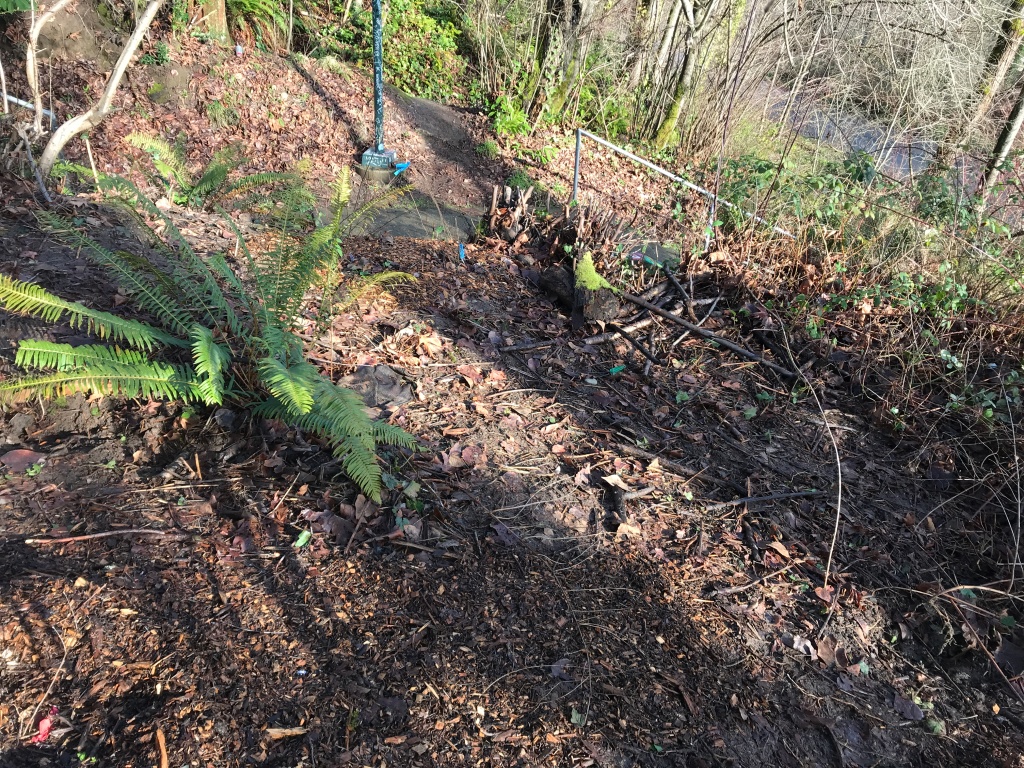Al and I bought a house on Beacon Hill in Seattle in November of 1973. Soon thereafter, we bought the lot behind our house. The properties on both sides of our new lot were completely overrun with blackberry vines; but our lot, thanks to the people who had lived there since sometime in the 1930’s, was well maintained. It was terraced and had several fruit trees. We added vegetable gardens and did our best to keep the property free of blackberry vines and weeds.
After we divorced in the 80’s, I sold the lot; there was no way for me to keep it up and I needed the income. At that point, the blackberry and ivy vines began to invade the property. The person I sold it to, sold it to someone else and that person sold it to the city when they were buying property to create the Seattle Greenbelt.
In 2014 and 2015, I attempted to remove some of the blackberry and ivy vines, particularly around big cedar tree and a big alder tree. Sometimes I enlisted a friend to help, but we barely made a dent in the invasive vines.
In March of 2015, I saw some yellow down by the alder tree and was intrigued; I wanted to see what it was. I picked up my shears and made my way through the dried blackberry vines. It was not easy to get to the yellow, which turned out to be daffodils, but I eventually made it.
The daffodils were beautiful and when I looked inside one of them, I was surprised to see a spider.
If you would like to read more about that 2015 adventure go to: Keep Your Eyes on the Prize)
In fall of 2016, GreenFriends members joined with Green Seattle Partnership in restoring this section of the Greenbelt. Our site not only included the lot I had once owned but three other lots as well.
A few days ago, I was looking out my kitchen window and saw yellow in the distance. I knew immediately what it was. I took a photo from the kitchen. Look at the photo below and see if you can see any hint of yellow.
Then I took a closeup photo, still from the kitchen window. Can you see the yellow in the distance now? Don’t worry if you can’t; you will be able to see it soon!
The next day, I decided to get as close as I could to the flowers. This time my journey would not be hampered by blackberry vines but it might be halted by my physical mobility issues (poor balance and dizziness). I decided the safest way for me to get to them was to walk down the Hanford Stairs, because those stairs have a handrail. I would also bring my cane.
Once I arrived at the entrance to the lower path, I left the stairs and entered the Greenbelt. There was so much new growth on the site. This unfolding fern was one of the first things that caught my eye.

Hanford Stairs 
Lower path 
New growth
Next, I noticed that several of the wild ginger plants we had planted in 2017 were now dwarfed by fringecup volunteers (volunteers in this case are plants that sprout on their own, i.e. we hadn’t planted them). In the photo below the wild ginger is peeking out from under the fringecup. Both are native plants.
As I came close to the main part of the site, I saw a flowering tree in the distance. What in the world was that?
Before I turned the corner into the clearing, I passed a planting area and saw that horsetails were coming up en force! I knew from experience, that before long we won’t be able to see anything other than horsetails in the lower areas of the site!
When I entered the clearing, the flowering tree mystery was solved; the blooms were on the top part of the big tree that had fallen during the first week in March.
(Click on any of the galleries to enlarge the photos.)
From this area, I was able to get a view of the fallen tree from a different perspective than I had before. There was still no way to capture all of the tree in one photograph.
Soon, I continued my journey to the daffodils. They were on a slope, so I didn’t feel safe to get close to them but I did take some closeup photos from the path.
Then I looked at the nearby planting areas.
I decided to return to my house using the stairs behind my house since I am much more stable going up stairs than down them. On the way back, I saw how much the pearly everlasting shoots have grown. And there are so many of them. If you would like to read my previous update about those plants go to: Pearly Everlasting Shrubs pp. 24-27.
The next day, I decided to see if I could get a little closer to the daffodils. I noticed that if I walked towards them from the south side, the ground was almost flat. I knew I still couldn’t take ground level photos like I did in 2015 but I was very happy to get a closer shot…

… and to have completed another adventure!






























































































































































